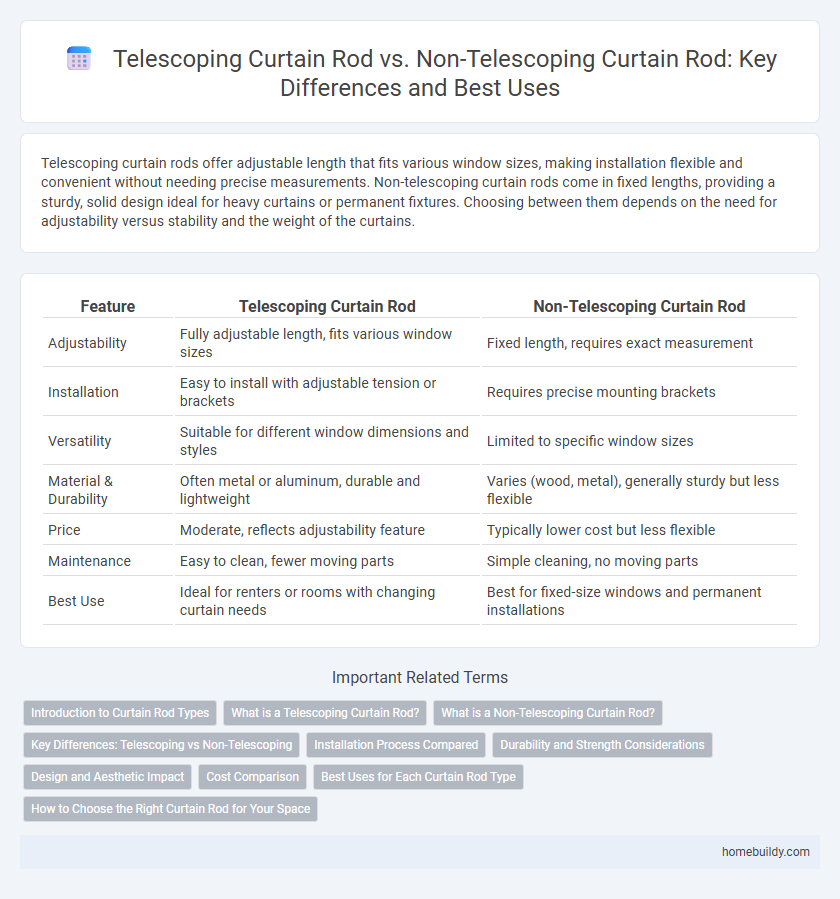Telescoping curtain rods offer adjustable length that fits various window sizes, making installation flexible and convenient without needing precise measurements. Non-telescoping curtain rods come in fixed lengths, providing a sturdy, solid design ideal for heavy curtains or permanent fixtures. Choosing between them depends on the need for adjustability versus stability and the weight of the curtains.
Table of Comparison
| Feature | Telescoping Curtain Rod | Non-Telescoping Curtain Rod |
|---|---|---|
| Adjustability | Fully adjustable length, fits various window sizes | Fixed length, requires exact measurement |
| Installation | Easy to install with adjustable tension or brackets | Requires precise mounting brackets |
| Versatility | Suitable for different window dimensions and styles | Limited to specific window sizes |
| Material & Durability | Often metal or aluminum, durable and lightweight | Varies (wood, metal), generally sturdy but less flexible |
| Price | Moderate, reflects adjustability feature | Typically lower cost but less flexible |
| Maintenance | Easy to clean, fewer moving parts | Simple cleaning, no moving parts |
| Best Use | Ideal for renters or rooms with changing curtain needs | Best for fixed-size windows and permanent installations |
Introduction to Curtain Rod Types
Telescoping curtain rods feature adjustable lengths, allowing for versatile window fitment without the need for precise measurements, making them ideal for varying window sizes. Non-telescoping curtain rods come in fixed lengths, offering a sturdy and often more decorative option, preferred for specific, predetermined window dimensions. Both types provide essential support for curtains, with choices influenced by installation flexibility and aesthetic preference.
What is a Telescoping Curtain Rod?
A telescoping curtain rod consists of two or more adjustable sections that slide within each other, allowing for easy length customization without cutting. Made from durable materials like aluminum or steel, these rods offer flexible fit for window widths ranging typically from 28 to 120 inches. Telescoping curtain rods provide a versatile and convenient solution for various window sizes and styles compared to fixed-length non-telescoping rods.
What is a Non-Telescoping Curtain Rod?
A non-telescoping curtain rod is a fixed-length rod designed to fit a specific window width without adjustment capabilities. These rods offer sturdy support for curtains but require accurate measurement before installation to ensure proper fit. Typically made from metal or wood, non-telescoping rods provide a classic look with minimal hardware complexity.
Key Differences: Telescoping vs Non-Telescoping
Telescoping curtain rods offer adjustable lengths, allowing easy customization to fit various window sizes without cutting or additional hardware. Non-telescoping curtain rods come in fixed lengths, providing sturdier support but requiring precise measurements and possible modifications for proper installation. The telescoping option provides versatility and convenience, whereas non-telescoping rods typically offer enhanced durability and aesthetic consistency.
Installation Process Compared
Telescoping curtain rods feature adjustable lengths that simplify the installation process by eliminating the need for precise measurements and additional cutting tools, making them ideal for quick setups. Non-telescoping curtain rods require custom cutting or exact sizing before installation, which can be time-consuming and may necessitate professional assistance to ensure a proper fit. The flexibility and ease of mounting telescoping rods often result in less installation time and greater convenience compared to their fixed-length counterparts.
Durability and Strength Considerations
Telescoping curtain rods offer adjustable lengths through nested metal tubes, but their joints can introduce potential weak points reducing overall durability compared to solid non-telescoping rods. Non-telescoping curtain rods, typically made from single-piece aluminum, steel, or wood, provide superior strength and long-term stability under heavy curtain weights. For applications requiring maximum support and longevity, non-telescoping rods are generally more reliable due to their construction and resistance to bending or sagging.
Design and Aesthetic Impact
Telescoping curtain rods offer a sleek, adjustable design that seamlessly fits various window sizes, enhancing modern and minimalist decor with clean lines and versatility. Non-telescoping rods often feature fixed lengths with decorative finials and more traditional profiles, contributing to a classic, structured aesthetic that can become a statement piece. Choosing between the two influences the room's visual balance by either emphasizing adaptability and subtlety or showcasing ornamental detail and stability.
Cost Comparison
Telescoping curtain rods typically cost more upfront due to their adjustable design and versatile installation options, while non-telescoping rods are generally less expensive with fixed lengths. The ability to customize length with telescoping rods can reduce the need for professional cutting or multiple rod purchases, potentially saving money in the long term. Budget-conscious buyers often opt for non-telescoping rods for simplicity and lower initial investment, but telescoping rods may offer better value in varied window sizes.
Best Uses for Each Curtain Rod Type
Telescoping curtain rods excel in versatile spaces where adjustable length is crucial, such as rental apartments or irregular window sizes, offering easy installation and flexibility without additional hardware. Non-telescoping curtain rods provide superior stability and aesthetic appeal for fixed window dimensions, making them ideal for formal rooms or heavy drapery that requires robust support. Selecting between these types depends on the need for adjustability versus strength and design consistency in a given space.
How to Choose the Right Curtain Rod for Your Space
Choosing the right curtain rod depends on window size, style preferences, and installation needs. Telescoping curtain rods offer adjustable lengths, making them ideal for irregular or varying window widths, while non-telescoping rods provide a fixed, sturdy option for standard-sized windows. Consider the weight of your curtains and desired ease of installation to determine whether flexibility or permanence best suits your space.
Telescoping curtain rod vs Non-telescoping curtain rod Infographic

 homebuildy.com
homebuildy.com